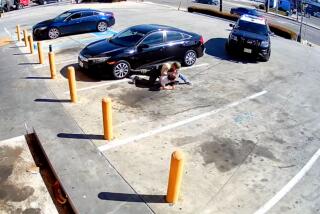How the case against Dodger Stadium beating suspect unraveled
- Share via
On a Sunday afternoon in late May, Los Angeles Police Chief Charlie Beck stood before a horde of television cameras in the sprawling parking lot at Dodger Stadium. His voice wavering with emotion, Beck told a riveted city he was confident his detectives had caught one of the men responsible for the beating of a San Francisco Giants fan in that same lot weeks before.
“This was a very difficult investigation, with a lot of moving pieces,” Beck said. “But this is a significant, significant break and one that will lead to a successful investigation I’m sure.”
Photos: Suspects in Bryan Stow beating charged
But already, doubts had begun to grow in the minds of prosecutors and some in the LAPD.
The case against the suspect, Giovanni Ramirez, hinged entirely on eyewitness identifications and circumstantial evidence. There was no hard evidence that placed the 31-year-old gang member at the stadium that day, let alone proved he committed the assault. Before arresting Ramirez, detectives had tried to find some definitive link and had come up empty.
In the weeks that followed, police continued to search for a phone record, a clip from stadium surveillance cameras, a credit card transaction — anything — that would make their case. Still, they found nothing.
The unraveling of the case against Ramirez reached its dramatic, if inevitable, end last week when two other men were arrested and charged with the assault on Bryan Stow, who remains hospitalized and has brain damage.
At another, very different news conference Friday, Beck once again went before the cameras to publicly announce that his department had exonerated Ramirez. “I want to tell the world Giovanni Ramirez is no longer a suspect in this case,” he said.
When you arrest the right person, things fall into place very quickly.... This one just hung out there,” Beck said.
In an interview after the news conference, Beck said: “When you arrest the right person, things fall into place very quickly.... This one just hung out there.”
Police have released few details about how they came to charge the new suspects, Marvin Norwood, 30, and Louie Sanchez, 29.
But law enforcement sources, who requested anonymity because of the ongoing investigation, said the new suspects surfaced after detectives came to believe that Ramirez was not the assailant and returned to the hundreds of clues and tips that had come in from the public.
The detectives noticed that several people who had been sitting in the same section of the stadium during the opening day game had reported seeing a pair of very aggressive, belligerent fans seated nearby, the law enforcement official said. From interviews with the people, detectives were able to narrow down the area and then pulled together a list of possible suspects from ticket sales records. Norwood and Sanchez jumped out as prime suspects.
Detectives learned that Dorene Sanchez, Norwood’s wife or long-term partner and Louie Sanchez’s sister, had attended the game with them. She fit the description of the woman witnesses saw driving the car the men jumped into after the attack.
The source said Norwood and Sanchez have implicated each other to detectives and added that police are confident Dorene Sanchez was the driver. Criminal charges against her are pending, Beck said Friday.
Prosecutors allege that Norwood and Louie Sanchez “did cut and disable the tongue, and put out an eye and slit the nose, ear and lip” of Stow, according to district attorney’s spokeswoman Sandi Gibbons.
While Beck and Mayor Antonio Villaraigosa said the abrupt change of course in the case demonstrates the LAPD’s commitment to pursuing the truth even if it means taking some public relations lumps in doing so, the case has exposed the department to difficult questions about how investigators came to focus so intently on Ramirez and remained so for so long.
It was a difficult case from the start.
The attack on Stow occurred at night in a poorly lighted parking lot. With too few police and security personnel on hand to adequately patrol the huge canvas of pavement, there was only a group of other fans on hand to witness the attack. No one recorded a license plate of the car the men jumped into. Afterward, investigators were chagrined to find that the two attackers had left no fingerprints or blood samples or other samples of their DNA that might help identify them.
Attention on the case was intense. With national and international media covering the beating, Villaraigosa, Beck and other city leaders were eager to prove that such lawlessness would be punished and that it was safe to attend games at one of baseball’s most storied venues.
Beck dedicated an extraordinary amount of resources to the case, assigning dozens of detectives to work exclusively on finding the attackers. But he also made the unusual decision to allow investigators from the department’s Northeast Division to handle the inquiry instead of transferring it to the elite Robbery-Homicide Division, which specializes in complex cases like this one.
Working off of a tip, police identified Ramirez as a possible suspect. When at least two witnesses picked him out of photo line-ups, investigators homed in. They tried to get cellphone records that would show he had been at the stadium, but were frustrated to discover Ramirez had no traceable phone records because he used — and discarded — disposable phones. A search of Dodger ticket sales records from the day of the attack failed to turn up proof he had bought a ticket.
But the identifications, along with some circumstantial evidence, added up in the minds of police — enough so that Beck gave the go-ahead for the arrest.
“When Northeast came to us, they had what appeared to be a good case. They had multiple witnesses that identified him, he lived in the same neighborhood … and given his criminal history, the fact that he’s on parole for a violent crime, his gang affiliation — knowing what we knew, we would have been derelict had we not made the arrest,” said Beck, who emphasized that a judge had to approve the arrest and search warrants before police took Ramirez in.
Beck said that detectives, in an eagerness to solve cases, often oversell the strength of their investigation when briefing supervisors. He acknowledged that may have been at play when Northeast investigators briefed him but said he considers it his responsibility to see through that.
Indeed, one of the law enforcement sources described the witness identifications of Ramirez as “weak and tentative.”
As the search for hard evidence stalled, Ramirez’s respected, veteran attorney, Anthony Brooklier, made compelling claims that his client was innocent. Beyond the more easily dismissible claims by friends and family members that they could vouch for Ramirez’s whereabouts at the time of the attack, Brooklier insisted that Ramirez submit to a polygraph exam.
The attorney hired Jack Trimarco, the former head of the FBI polygraph unit in Los Angeles, to test whether his client was telling the truth. Trimarco recalled in an interview how he asked a series of questions in preparation for the test, including what areas of the stadium Ramirez would consider Dodger property.
Ramirez replied that he had never been to Dodger Stadium, didn’t like baseball and wasn’t a sports fan. Trimarco pressed on, asking whether Ramirez would consider the stadium restrooms as Dodgers property.
“Yeah,” Ramirez replied.
The baseball field, asked Trimarco? Ramirez answered yes. “How about the bullpen?” Trimarco recalled asking.
“What’s a bullpen?” Ramirez replied.
The test posed two key questions: Had Ramirez been on Dodger Stadium property on opening day and was he at Dodger Stadium when Stow was attacked. Ramirez answered “no” to both.
“When I walked out … there was no doubt in my mind that the LAPD had got the wrong guy,” he said.
Still, Northeast detectives continued to press for evidence against Ramirez. Beck, meanwhile, repeatedly affirmed his confidence in the case, rebuffing questions of whether he was growing doubtful.
Behind the scenes, however, the investigation was shifting. Beck decided to take control of the case away from Northeast detectives and hand it to Robbery-Homicide. It was a tacit acknowledgment that the case needed fresh, more experienced eyes. The detectives essentially started from scratch, with some working to prove or disprove Ramirez’s alibi and others combing the clues for new leads. About two weeks ago, they identified Norwood and Sanchez.
Photos: Suspects in Bryan Stow beating charged
Beck defended the way the case has unfolded, saying, “This is not a movie. This is real life. This was a very difficult case.... We didn’t have a bunch of forensics, didn’t have any DNA, any prints. There were several things that would have made this a better case, but we did have enough probable cause to make an arrest” of Ramirez.
But attorneys representing Ramirez’s family accused police of having tunnel vision as they tried to make their case.
“This was a case that began to nose dive and crash immediately after the initial press conference,” said Jose Romero, part of Ramirez’s legal team.
Times staff writers Andrew Blankstein and Richard Winton contributed to this report.
More to Read
Sign up for Essential California
The most important California stories and recommendations in your inbox every morning.
You may occasionally receive promotional content from the Los Angeles Times.












